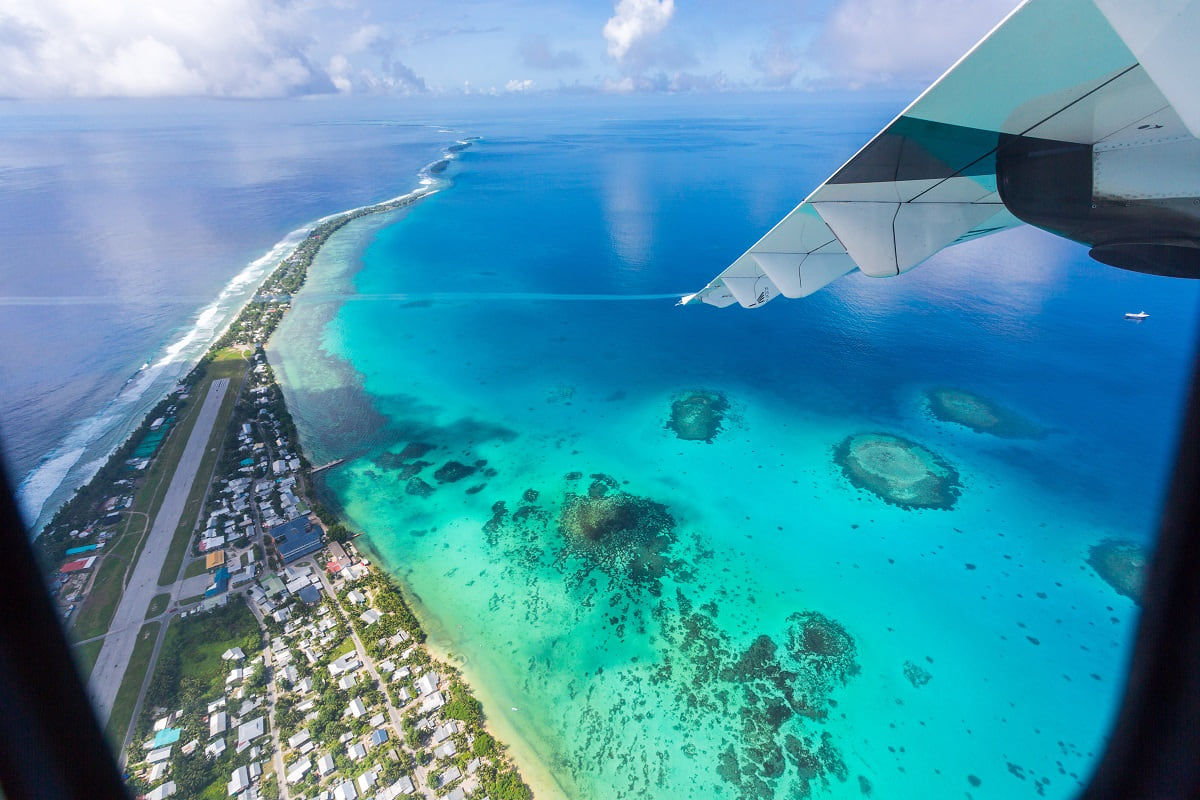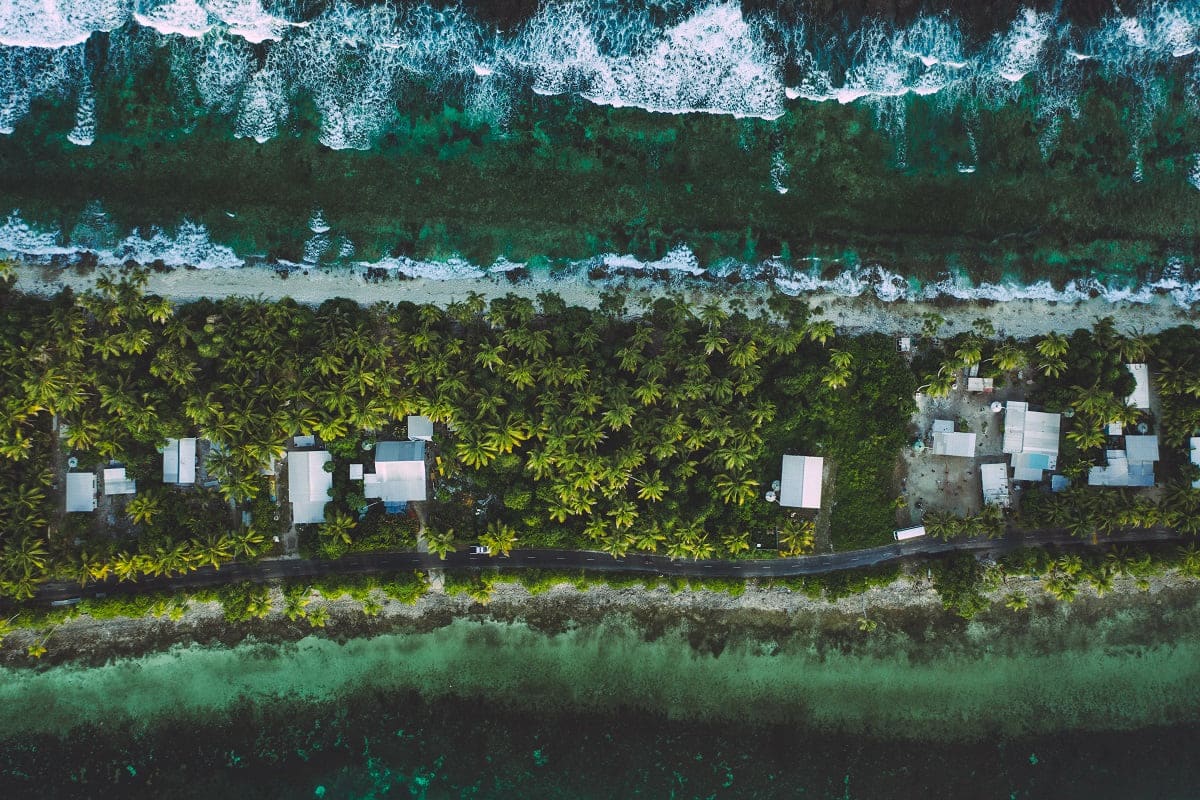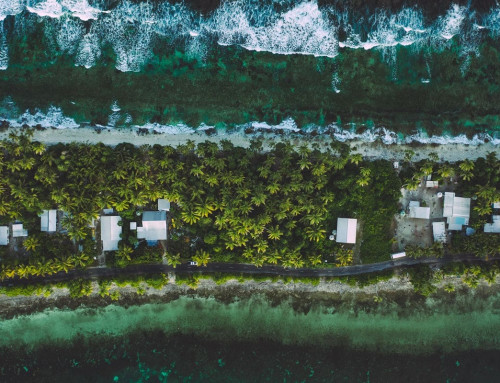Located in the middle of the South Pacific Ocean, the Tuvalu Islands are one of the world’s most complex destinations to visit. Geographical isolation, the fact that the archipelago stretches for hundreds of kilometers and a sweltering equatorial climate make it an atypical stop-off point in the exploration of wider Polynesia. Find out when and how to get to Tuvalu!
When to Go to Tuvalu: Choose the Right Season
November to April: High Tide and Typhoon Season
With an average temperature of 30°, the Tuvalu Islands experience hot temperatures and high humidity during the rainy season. Although they never last very long, showers are more frequent and very powerful, especially on Funafuti. The absence of tarmac roads makes the terrain muddy, and the lagoon’s shores are often murky, losing their beauty.
The period sees high tides that flood the inland areas to the depths, wreaking havoc on what little agricultural land there is. This natural phenomenon occurs mainly in January and February. Added to this recurring catastrophe for the soil and the population is the risk of cyclones, which periodically ravage certain islands in the archipelago, destroying vegetation and makeshift dwellings. These recurring disasters make a stay in Tuvalu hazardous and complicated. It is therefore best to avoid visiting during the rainy season.
May to October: A More Pleasant Season
From May onwards, visiting conditions are more pleasant. Rains become less frequent, and the risk of typhoons becomes almost anecdotal. Temperatures remain high, but average around 26°. Daily life emancipates itself from the heat in the late afternoons and the atmosphere is very relaxed: enjoying the fine weather after the high tides of February.
The lagoon regains its splendor for the pleasure of those wishing to undertake kayak or boat excursions. It’s the ideal time of year for a trip to the archipelago. The best months to visit Tuvalu are from August to mid-October.
Getting to Tuvalu: Flights and Formalities

Find a Flight to Tuvalu
There are no direct flights from North America or Europe to the Tuvalu archipelago. The only gateway is already in the Pacific Ocean: the Fiji Islands. You’ll need to travel there first to reach Fanufuti, the capital of Tuvalu. Expect a total budget of between USD 1,100 (one stopover) and USD 2,100 (two or more stopovers).
For travelers from North America’s West Coast (Los Angeles, San Francisco, Vancouver), Australia (Sydney, Camberra), New Zealand (Auckland, Wellington), Hawaii (Honolulu), Japan (Tokyo) and New Caledonia (Nouméa), weekly flights connect Nadi International Airport directly to Fiji. Allow between 5 and 12 hours’ flying time. Travelers from the rest of the world will need to make a stopover at one of the above-mentioned airports. From Nadi airport, only one or two flights will take you to Tuvalu in three hours.
Once on Funafuti, you can ask the locals for advice on how to get to your hotel or guesthouse. In any case, let your hosts know of your arrival so that they can make the necessary arrangements. If, on the other hand, you intend to extend your journey to the outer islands of the archipelago, you’ll need to take a sea shuttle, which is also used for provisioning and fishing. The journey lasts from one night to several days. Unfortunately, traffic is unpredictable. Transport may be postponed or even cancelled, depending on weather and sailing conditions.
Travel Requirements for Tuvalu
Tuvalu is very flexible when it comes to international visitors. Travelers from the Schengen area in Europe, the USA and the UK can obtain a free visa valid for 90 days upon arrival on Funafuti. A valid passport and up-to-date vaccination certificate are required.
Other conditions: the Tuvaluan government may require presentation of a return air ticket and confirmation of an accommodation reservation. So remember to book a hotel or guesthouse before you arrive in the archipelago.
Where to Stay on Funafuti: Hotels in Tuvalu

The archipelago’s few hotels and guesthouses are located on Funafuti. Don’t expect superlative comfort! These are the realities of a micro-island state isolated from the rest of the world. Internet connections are very weak, power cuts can occur and water is rationed. As a reminder, running water is collected when it rains and stored in cisterns, so it must be used sparingly.
We particularly recommend three Polynesian-style addresses. The Esfam Hotel is the most hotel-like. Filamona Lodge is a wonderful guesthouse. Close to the airport, both offer friendly accommodation. For total relaxation in contact with nature, check out the Afelita Island Resort on a motu ten minutes by boat from Funafuti. Expect to pay around USD 40 per night.
Your friendly hosts will introduce you to Polynesian culture. With simplicity and respect, they’ll show you their love of dance, nature and community. You’ll be less a guest than a client: a willingness to learn and mutual respect are the watchwords in Tuvalu.
A Journey to the End of the World
Getting to Tuvalu is a complex process. Once you arrive at your destination, the journey seems well worth it. In the end, you’ll find few tourists and plenty of authenticity in contact with a friendly, welcoming population. Are you ready to take the plunge? Contact us to start your trip to the South Pacific Islands.



Leave A Comment